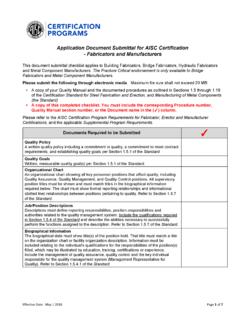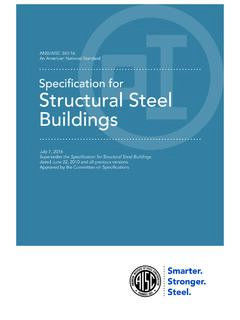Transcription of steelwise - AISC
1 SEPTEMBER 2016 STRENGTH AND ENGAGEMENTN otes on thread strength and partial engagement of anchor rod anchor ROD has its , we ll discuss the limit state of thread stripping in threaded steel anchor rods ( anchor bolts), used with nuts, for diameters, D, from in. to 4 in. Internal threads (nuts) or external threads (threaded rod) could strip under certain conditions. This limit state can usu-ally be avoided by having a suitable type of nut fully engaged with the threaded fastener. A thread s strip strength depends on both its geometry and material. An external unified coarse thread (UNC), whose cross section is approximately triangular, is wrapped as a helix around a solid cylinder. The number of threads that resist load depends on the thread spacing, or pitch, and the engaged length of the nut with the fastener, parallel to the fastener s longitudinal axis.
2 Load PathThe load path for a tension-loaded threaded fastener with a heavy-hex nut is shown in Figures 1a and 1b. For example, a base plate pushes up against a washer which then pushes against a nut. The nut s threads then push against the corresponding threads of the anchor rod. The anchor threads in turn transmit most of the load into the root diameter portion of the rod the solid cylinder portion producing tension stress. However, some of the tension force remains in the threads because they are integral with the root cylinder. For tension, the effective stress area of the anchor rod is its tensile stress area AT, which is less than the gross area AG but greater than the root area. See Equation 1, (per references 1, 2, 3 and 6) and Equation 2 (per references 3 and 5).
3 The ratio of AT to AG is not a constant, and ranges from to , as shown in Figure 3. Thread spacing n, in threads per inch, varies from 13 to 4 for this diameter range (see Table 1). Table 1 Diam. (in.)n (threads/in.)Diam. (in.)n (threads/in.)Diam. (in.)n (threads/in.) 131 72 49 161216345 8111 63 4 101 53 47 4182 872 4AT = ( /4) (D [ ])2 (1)AG = ( /4)D2 (2)BY JAMES LABELLE, PE, DocEJames LaBelle is a senior associate with CSD Structural Engineers in engagedFully engagedFigure 1a and 1bsteelwiseFigure 2. (Note: While protrusion through the nut is shown in the fully engaged example above, it is not necessary for full engagement.) Modern STEEL CONSTRUCTION 1 2 3 4 Diameter (in.)
4 Safety Factor, SFFigure 6. Safety Factor SF vs. Diameter, for UNC Threaded Fasteners (Tension; = ) 1 2 3 4 5 Diameter (in.)Strip Area per Inch ( )Figure 5. Strip Area per in. vs. Diameter (UNC Thread) 1 2 3 4 5 Diameter (in.)Strip Area ( )Figure 4. Strip Area per Thread vs. Diameter (UNC Thread) 1 2 3 4 Diameter (in.)AT / AGFigure 3. Ratio AT/AG vs. Diameter, for UNC Threaded FastenersThread StrippingThe engaged threads of the nut and rod are resisting load via local shear stress along the engaged length.
5 Stripping occurs if the shear stress in the nut or the rod threads reaches the ulti-mate shear stress. A thread s shear stress depends on the force per thread and the stripping area per thread. Prior to stripping, shear yielding will typically occur. See Eq. 3 and Eq. 4 for strip-ping areas, per thread, for external and internal = c [(1/(2n)) + (1/ 3)(b c)], ext. thread (3)ATSI = a [(1/(2n)) + (1/ 3)(a d)], int. thread (4)where c = maximum minor diameter of internal threadb = minimum pitch diameter of external threada = minimum major diameter of external threadd = maximum pitch diameter of internal threadThe preceding variables for bolts and nuts are given in refer-ences 1, 2 and 3. Figure 4 is a plot of the strip area per thread, and Figure 5 illustrates the strip area per inch, for external and internal threads.
6 To better understand thread stripping, it is helpful to know that an external thread s strip area per thread is significantly smaller than that of the corresponding internal thread. Thus as long as the bolt material s tensile ultimate stress FU does not ex-ceed that of the nut, the bolt threads strip strength governs the stripping failure mode. The ratio of ATSE to ATSI ranges from to In an idealized simple model, engaged threads would con-tact uniformly along the full length of the helix. The bolt would be rigid and the force on each thread would be the same for a given bolt tension. In reality though, there is variation. Steel s elasticity and ductility, tolerances in fabricated threads and the geometric details of a nut and anchor rod all contribute to vari-ation in the force per thread.
7 For example, the threads closest to the loaded face of the nut resist a disproportionately high frac-tion of the total load. Within limits, a sufficiently high tension will cause local yielding of some threads and allow for partial redistribution of force among aspect of nut behavior is the dilation, or increase in di-ameter, that occurs as the applied tension force increases. This response is due to the radial component of force per thread that is caused by the sloping contact faces of the triangular cross-section threads. Proper nut design limits this behavior. SEPTEMBER 2016 Partial EngagementIf a nut is not fully engaged with an anchor rod (see Figure 2) and the required tension is less than the rod s full allowable, then there are design methods that can be used to evaluate structural adequacy.
8 Method 1 (AISC Design Guide 1: Base Plate and anchor Rod Design, 2nd ed.) conservatively limits the engagement length LE to a minimum of half of the nut s height h. At this minimum engagement, the reduced allowable rod tension TA1 is considered to be half of its full (basic) allowable TA. Partial-engagement lengths in between 50% and 100% of the nut height result in linear reductions of TA: TA1 = (LE/h)TA (5)where h LE hMethod 2 (AAMA Design Guide for Metal Cladding Fasteners) involves the use of an approximate equation for allowable bolt tension TA2, which is based on external thread strength and the average load per engaged thread: TA2 = FSUATSEnLE /SF2 = FSUATSEULE /SF2 (6)whereFSU = ultimate shear stress for anchor , ksiATSE = stripping area per external thread, SF2 = safety factor for Method 2 ATSEU = stripping area per unit length of external thread, FSU = FU/ 3 and SF2 = per reference 3.
9 Heavy-hex NutA suitable heavy-hex nut (HHN, fully engaged) will, without thread stripping, allow a matching bolt or anchor to develop its tensile ultimate at the threaded cross-section. By calculation, using the external threads minimum strip-strength and the average force per bolt thread, a HHN can develop at least times the minimum tensile ultimate of the threaded s an example: UNC thread series, D = in., n = 7 threads/in.; anchor rod is ASTM F1554 Gr. 36 (FU = 58 ksi); heavy-hex nut (Grade A) for which FU > 58 ksi, height h = in. (A regular-hex nut for this diameter has a height of 7 8 in., which is 70% of the HHN s height. Also, a Grade A ASTM A563 heavy-hex nut must be able to support a proof load due to a fully-engaged threaded fastener stressed in tension to 100 ksi, based on AT).
10 Eq. 7 from reference 5 gives the basic allowable tension TA for the anchor = (7) = (58 ksi)( ) = kips, the basic allowable tension of anchor rodMethod 1. Assume that the nut can be engaged with the rod for only 7 8 in. Use Method 1 to find the reduced allowable tension. Verify that at least half of the nut height is engaged: (7 8 in.)/( in.) = 70% > 50% OKTA1 = (LE/h)TA = (7 8 in.)( k) = kips; Method 1 Method 2. In this case, the nut has a total of threads ( in. 7 threads/in.), but only threads are engaged. Now use Method 2 to find the reduced allowable = FSUATSEnLE/SF2 = (58 ksi / 3)( )(7 threads/in.) ( in.)














